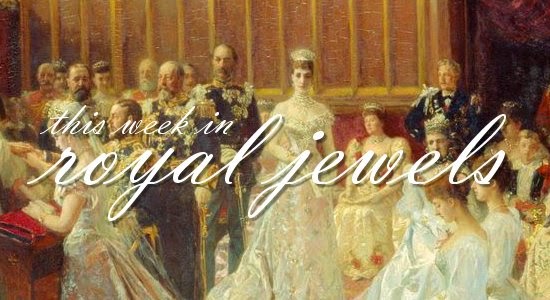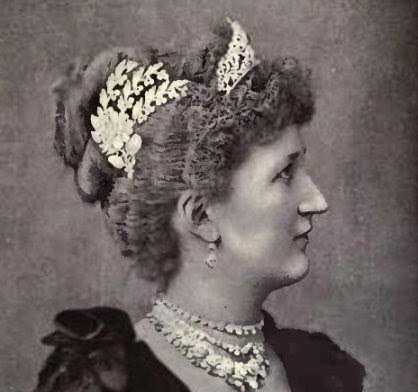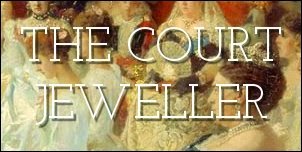
This Week in Royal Jewels: March 20-26

Sparkling Royal Jewels From Around the World

LONDON, Mar. 26 — At the two courts held this spring, rubies were the favorite gems, and some of the finest of these stones in England were to be seen. At the first court, Queen Alexandra wore the Cullinan diamond [1], and at the second she wore on her corsage the famous Agincourt stone, a pigeon’s blood ruby which belongs to the crown of England [2; pictured below in the Imperial State Crown].
Another wonderful ruby, which makes rare appearances in public and was visible at the second court, was Lady Carew’s [3] uncut stone of 133 carats, which is over an inch long. It was obtained in Persia by Lady Carew’s great-uncle [4] some 50 years ago. On its four sides it carries the names and titles of the four great emperors to whom it belonged.
 |
| Julia, Lady Carew (not wearing the “ruby”) [source] |
It has been bored from end to end, and has evidently been worn as a necklace or armlet threaded on a cord. Lady Carew has had it mounted with a diamond for suspension from a neck chain, and it is as a pendant that she wears it. Her jewelers were anxious it should be mounted in a tiara, but that would not show the inscriptions, which form its most remarkable feature. The fact that four Eastern emperors had their names incised upon it proves that it must have been regarded as a treasured heirloom and a powerful talisman [5].
Other wonderful rubies seen at the courts were the Duchess of Norfolk’s [6] cluster, the Duchess of Bedford’s [7; pictured above] pendants, and the necklaces of Mrs. Harry Higgins, Mrs. Burns, and Mrs. Ogden Mills, three American hostesses in London [8].
NOTES
1. Read my extensive post on the Cullinan Diamond here.
2. The “Agincourt stone” referenced here is the Black Prince’s Ruby, which is actually a spinel. Weighing more than 130 carats, the spinel is today mounted in the Imperial State Crown. Tradition states that Henry V wore the stone at the Battle of Agincourt in 1415.
3. Julia, Lady Carew (ca. 1864-1922) was born Julia Lethbridge in Ontario. She married Robert Carew, 3rd Baron Carew in 1888.
4. Lady Carew’s great-uncle was Charles Alison, a diplomat who served as Queen Victoria’s Envoy Extraordinary and Minister Plenipotentiary to the Shah of Persia (present-day Iran) from 1860 to 1872. Alison’s sister, Julia Alison Hill, was Lady Carew’s maternal grandmother. Sources say that Lady Carew spent several years in Persia during her great-uncle’s tenure there.
5. The “ruby” mentioned here is actually the Carew Spinel (making this article two-for-two on rubies that aren’t rubies). After her death, Julia Carew bequeathed the stone to the Victoria and Albert Museum in London, where it is on display today in the South Asia gallery. The museum’s records date the spinel to the Mughal court of the 17th century. Charles Alison is said to have acquired the stone in Tehran around 1870.
6. Gwendolen Constable-Maxwell (1877-1945), wife of the 15th Duke of Norfolk.
7. Mary Tribe (1865-1937), aviator, suffragette, ornithologist, and wife of the 11th Duke of Bedford.
8. These three American hostesses were Marie Louise (Parsons) Higgins, wife of Henry Vincent Higgins, Covent Garden Opera manager and chairman of the Ritz Hotels in London and Paris; Mary Lyman (Morgan) Burns, sister of J.P. Morgan and mother of Viscountess Harcourt; and Ruth (Livingston) Mills, wife of banker and horse breeder Ogden Mills and sister-in-law of Whitelaw Reid, the American ambassador to Britain.
It’s no surprise that royal ladies around the world have an affection for aquamarines, the clear and bright gemstone beloved by those born in March. Here are my top ten royal aquamarine jewels — add your list in the comments below!
An engagement present from Nicholas II of Russia to his future wife, Alix of Hesse, this lovely brooch features a large Siberian aquamarine. He purchased the piece in St. Petersburg at Fabergé and presented it to Alix in August 1894. Today, it’s in the collection at Wartski’s in London.
The late Belgian queen frequently wore a number of pieces of aquamarine jewelry at gala events, including a pair of delicate drop earrings, a pendant, and the aquamarine-studded version of her wedding gift tiara.
It’s hard to think of a better word than “fun” for the exuberant suite of aquamarines owned by the Dutch royals, from the sparkling briolettes of the tiara to the gorgeous aquamarine pendant often worn suspended from a brooch.
We looked earlier this year at the numerous aquamarine pieces worn by the Countess of Wessex; my favorite is the diamond and aquamarine tiara lent to her by her mother-in-law, Queen Elizabeth II.
This gorgeous aquamarine kokoshnik, which also has a matching brooch, is often worn by the king’s sisters, Margaretha and Christina; it was also worn by their mother, Princess Sibylla.
The future Danish queen owns a number of aquamarine pieces, including this lovely pair of girandole earrings, which pair well with both white-tie glitter and more subdued gala dress.
The grand ducal family of Luxembourg keeps this set of aquamarine jewels, which also includes a fabulous Art Deco-style aquamarine bandeau, in their palace vault.
Worn today by Queen Elizabeth II, this lovely diamond and aquamarine brooch is probably a set of double clips. The Queen Mother began wearing it in the 1930s.
In terms of sheer aquamarine brightness and power, it’s tough to outclass Queen Elizabeth II’s suite of aquamarine jewelry, given to her at various times during her reign by the people of Brazil.
Worn most recently in public by Princess Sibilla of Luxembourg, these astonishing aquamarine jewels were originally owned by Queen Ena of Spain, Sibilla’s great-grandmother. The tiara has since been remade, but the briolette aquamarine drops are as sparkling as ever.
